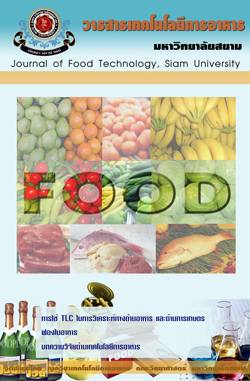การผลิตโยเกิร์ตกล้วยหอม
Main Article Content
Abstract
งานวิจัยนี้มีวัตถุประสงค์เพื่อศึกษาการผลิตโยเกิร์ต กล้วยหอมโดยใช้เชื้อโยเกิร์ตที่เหมาะสมต่อการเกิดเคิร์ด คือ 12 กรัมต่อนำ้ นม 100 กรัม และแปรปริมาณกล้วยหอมที่ แตกต่างกัน คือ 5, 10, 15 และ 20 กรัมต่อนม 100 กรัม ตามลำดับ โดยใช้กล้วยหอมที่มีอายุ 90 วัน เมื่อทดสอบทาง ประสาทสัมผัส พบว่าโยเกิร์ตที่เติมกล้วยหอม 10 กรัม ผู้บริโภคให้การยอมรับมากที่สุด แต่พบว่าโยเกิร์ตที่ผลิตได้ทุก สูตรมีสีนำ้ ตาลเกิดขึ้น ดังนั้น จึงศึกษาวิธีการควบคุมการเกิดสีนำ้ตาลในกล้วยหอม โดยวิธีทางกายภาพและเคมี ซึ่งวิธีทางกายภาพทำโดยการลวกที่อุณหภูมิ 85 °C พบว่าการลวกเป็น เวลานาน 8 นาทีสามารถควบคุมการเกิดสีนำ้ตาลได้ดีกว่า 6 นาที ส่วนวิธีทางเคมีทำโดยการแช่ในสารเคมี พบว่ากล้วยหอมที่แช่ใน 0.5% ascorbic acid นาน 20 นาที สามารถ ป้องกันการเกิดสีนำ้ตาลได้ดีกว่า 0.5% citric acid นาน 20 นาที ดังนัน้ ในการผลิตโยเกิร์ต จึงเลือกใช้ ascorbic acid ใน การป้องกันการเกิดสีนํ้าตาลที่เกิดขึ้น และทำการวิเคราะห์องค์ประกอบทางเคมีของโยเกิร์ตกล้วยหอม พบว่ามีความชื้น คาร์โบไฮเดรต โปรตีน ไขมันและเถ้า ร้อยละ 81.99, 11.84, 3.27, 2.31 และ 0.55 ตามลำดับ และศึกษาการเปลี่ยนแปลง ของโยเกิร์ตกล้วยหอมในระหว่างการเก็บรักษา พบว่าความ คงตัวของโยเกิร์ตไม่เปลี่ยนแปลง เมื่อเก็บไว้ที่ 4 องศาเซลเซียส นาน 3 สัปดาห์
Production of Yoghurt Mixed Gross Michel Banana
The main objective of this research was to determine the optimal condition for producing the banana yoghurt. The starter culture concentration at 12 g/100 g of milk was suitable to be a standard yoghurt formula as it gave the best curd. Consequently, the variation of quantity; 5, 10, 15 and 20 g/100 g of milk, of banana harvested at 90 days was investigated. Sensory assessment in terms of color, flavor, taste, viscosity and overall acceptance demonstrated that yoghurt mixed with 10 g of bananas had the highest acceptance score. However, browning occurred in yoghurt of all formula; therefore, prevention of reaction by physical and chemical treatment was conducted. It was found that bananas blanched in hot water at 85 °C for 8 min inhibited browning reaction better than 6 min. Bananas soaked in 0.5% ascorbic acid for 20 min could inhibit browning reaction better than 0.5% citric acid for 20 min. Therefore, ascorbic acid was selected for browning prevention. The proximate analysis of banana yoghurt was as following: moisture 81.99%, carbohydrate 11.84%, protein 3.27%, fat 2.31% and ash 0.55%. Banana yoghurt could be kept at 4°C for 3 weeks without changing in stability.Article Details
Copyrights of all articles in the Journal of Food Technology available in print or online are owned by Siam University and protected by law.


